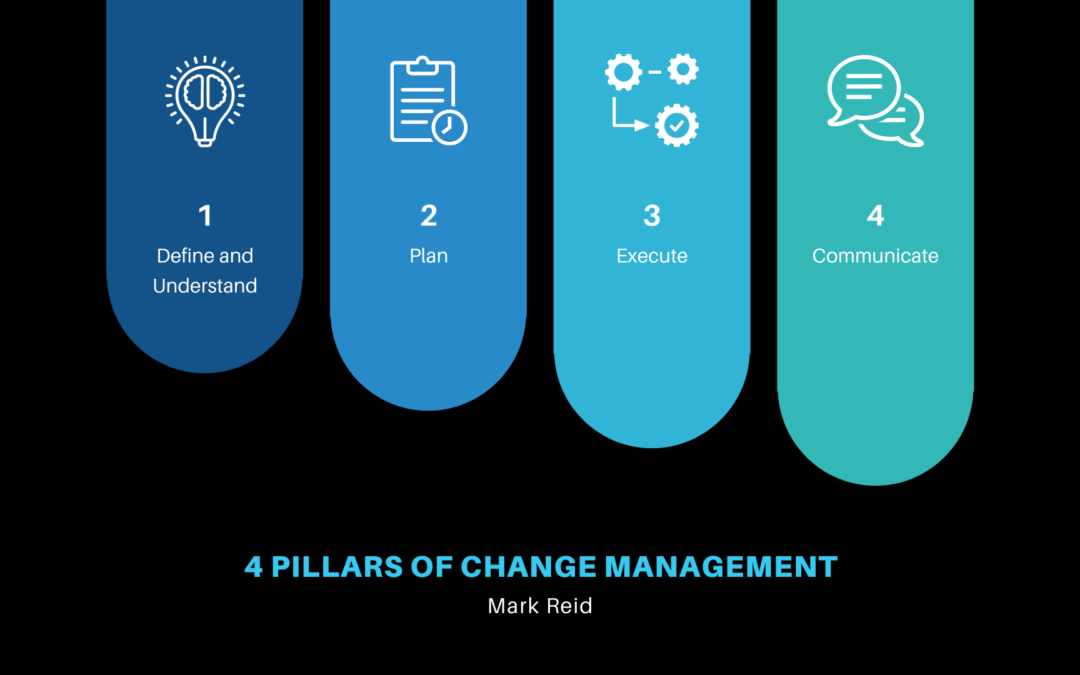We can all acknowledge that change is both inevitable and continual, as often reverberated in the phrase, “the only constant is change”. And while no business sits on its laurels and avoids change, it always amazes me how so many organizations get change management wrong.
When things go wrong, blame is often misplaced, and that’s where proper change management comes in. It’s intended to be a mindful and purposeful approach with the goal of getting change right (achieving desired outcomes) and it all starts with leadership.
In the first of a 3-part blog series, I’ll be discussing how to make a positive and productive change by following four core principles of change management.
What Is Change Management?
First, let’s define what change management is. ACMP, the Association of Change Management Professionals, defines it this way: “The practice of applying a structured approach to transition an organization from a current state to a future state to achieve expected benefits.” There are other models to draw from, like Kotter’s 8-Step Change Model, McKinsey 7s, Lewin’s Change Management Model or Kübler-Ross change management framework that will provide similar definitions, but the ACMP definition is my favourite.
Regardless of the model, a common thread that exists throughout is that no change ever happens in a vacuum: change affects the whole organization and all employees. The good news is that with properly planned change management, you can prepare your organization and employees within for success.
The Four Pillars of Change Management
While there are many models and several different processes within each model, there are 4 tenets to change management, and they all revolve around people – both you and your employees:
- Define and understand the change and impact on your people
- Plan the change and impact of the change on your people
- Execute the change with your people
- Communicate the change to your people
Define and Understand the Change
Defining and understanding the change focuses a lot on you and your leadership team. It’s imperative that you define what the change is and understand the need for change so that you can lead through the steps of promote, plan, implement and sustain. This ranges from determining the why through defining key objectives to determining the benefits to the organization and business. It means understanding the impact to your organization and people, including how they do their work and what they need to do it. And finally, it means determining how successful change will be sustained. The key here is that you must define and understand the change; if you don’t, it’s unlikely anyone else in your organization will understand it and the change you are wanting to make will likely fail.
Plan the Change
To make change happen, you must have a plan on how to make it happen. Every organization will also make change happen differently, so you will need to determine the way that is best for your organization, culture, and people.
What’s unlikely to vary in change is:
- Finding sponsors and leaders, including determining the high-level support needed and how to secure it.
- Getting the right people involved. Can it be done with internal resources, or do you need external help?
- Winning support from key people across the business. How do you plan to achieve this?
- Achieving the desired results. Determine the goals you need to achieve, and which milestones and Key Performance Indicators (KPI’s) will be strong indicators of success.
Execute the Change
Now that you’re done planning for change, next you need to execute. Included in the many change management models, there are different strategies you can deploy from creating a sense of urgency to build momentum or to overcome resistance between processes and employees within a company. Regardless of strategy, there are key aspects that should be included to affect change in a positive way:
- Everyone needs to understand what needs to happen
- There needs to be clear, agreed-upon success criteria, measured and reported against on a regular basis
- Stakeholder roles need to be defined and articulated
- Training needs must be identified and put in place – no point in having your folks know the change but not able to effectively perform their new roles
- Seek endorsements from change agents; they will help get things in place and role model the change
- Support your people through the change; take an active and present role to ensure support is there when it is needed, and however often it is needed
Communicate the Change
You can have the best intentions and the best plan in place, but without effective communication, you can easily fail in your change efforts. The change must be clearly articulated and relevant to your people from the start and throughout the change process, so that they understand what they need to do and why they need to do it.
Communicate in a frequent and planned manner so they’re supported by facts and data. It only takes 2-4 weeks without you letting employees knowhow things are going before they start to fill in the blanks with their own, and frequently wrong, assumptions and conclusions. Equally as important, you have to set the right tone for change. So, in addition to their heads you capture their hearts; always linking back to your corporate Mission, Vision, and Values. Finally, it is imperative to manage and communicate with your stakeholders, providing the right message at the right time ensuring continued support for your change.
In part 2 of this series, we’ll take a more practical look at leading change and making it happen by adapting GE’s Change Acceleration Process (CAP).






